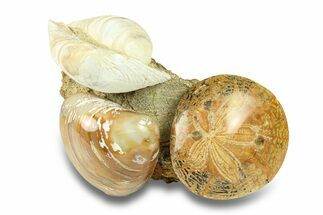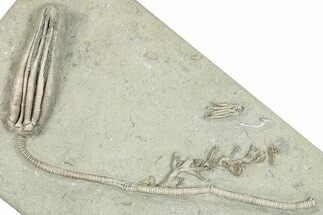This Specimen has been sold.
2.9" Fossil Sand Dollar (Encope) - Florida
This is an exquisitely preserved fossil sand dollar of the species Encope tamiamiensis. It comes from the Tamiami Formation of Southern Florida. This formation dates to the late Miocene through Pliocene periods. The fossil has been completely removed from the surrounding, limestone matrix.
A sand dollar is a highly flattened form of urchin of the order Clypeasteroida. As an echinoderm, they have a pentameral (five-fold) symmetry to their body organization, a water vascular system, and an endoskeleton made of calcite plates. They live in shallow marine environments just below the low tide line, buried in the sand or mud. They range up to about 4 inches (10cm) in diameter. Most are about a third (7mm) to half (12mm) an inch thick, but some are over an inch thick. They are basically circular in shape, though some have flattened or indented sides. While alive, they are covered with velvety-looking spines that they use to move, much like other echinoderms. The most diagnostic indicator of fossil sand dollars is the five ovate form on the top side of the skeleton. These are part of the respiratory system and leave an easily identified “flower” on the skeleton. They are active predators, feeding on crustacean larvae, small copepods, diatoms, and algae.
Sand dollars first appeared in the Paleocene, about 60 million years ago. By the middle Eocene, they had populated every ocean. As an order, sand dollars are still robust today: 49 genera of sand dollars are extinct, but 29 are still living.
Sand dollars first appeared in the Paleocene, about 60 million years ago. By the middle Eocene, they had populated every ocean. As an order, sand dollars are still robust today: 49 genera of sand dollars are extinct, but 29 are still living.
SPECIES
Encope tamiamiensis
AGE
LOCATION
Southern Florida
FORMATION
Tamiami Formation
SIZE
2.9" wide
CATEGORY
SUB CATEGORY
ITEM
#156319
We guarantee the authenticity of all of our specimens.
 Reviews
Reviews











